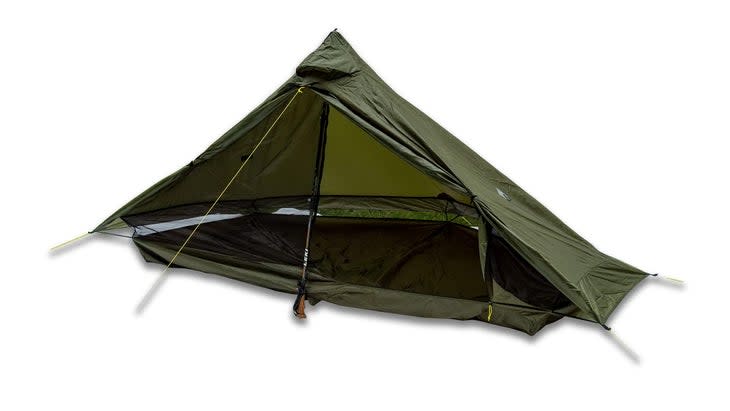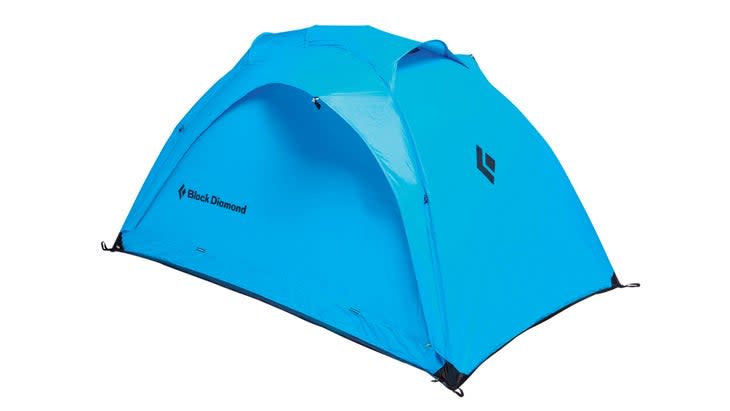Could This Fabric Revolutionize Ultralight Backpacking Tents?
This article originally appeared on Backpacker
When it comes to ultralight backpacking gear, the importance of silnylon can't be overstated.
The simple fabric construction--lightweight ripstop nylon impregnated with a waterproof silicone coating--has existed at a sweet spot between performance and price for decades. Compared to most other fabrics with waterproof coatings, it's far lighter, but not much more expensive. On the other hand, super ultralight composite fabrics like Dyneema are double or triple the price. Since it first caught on in the '70s, silnylon has been instrumental in the creation of lightweight, budget-friendly backpacking gear. It's used in tarps, tents, and rainflies, as well as dry bags, stuff sacks, pack covers, ponchos, and rain skirts, just to name a few.
But in recent years, another fabric have begun to challenge silnylon's dominance, especially as a shelter material. The competition? Silicone-coated polyester, or silpoly. In the past five years, the number of ultralight polyester tents available on the market has skyrocketed. As is often the case with ultralight innovations, cottage companies are leading the charge.
Polyester has long been a staple tent and tarp material--just check any big-box store for inexpensive car-camping tents and you'll find polyester. But for many years, polyester didn't cut it when it came to lightweight and high-performance gear. Compared to nylon, polyester was consistently weaker and less abrasion-resistant, and creating a durable polyester tent required the use of heavier fabrics.
In the past decade, however, technology has come a long way. Today, silicone-coated polyester is strong and light enough for use in ultralight gear. As a bonus, polyester has some inherent characteristics that nylon lacks. For some brands, that's been reason enough to make the switch.

"Compared to silnylon, silpoly has very little stretch and deflection when under tension," says Whitney La Ruffa, vice president of sales and marketing at Six Moon Designs. "This creates less sag overnight, helping to keep that perfect pitch until the morning." Six Moon Designs was one of the first brands to adopt silpoly, introducing it in two of its most popular tent models, the Lunar Solo and Skyscape Trekker, in 2018.
"Because silpoly was a new and untested material on a large scale when we started using it, we decided we should walk before we run," La Ruffa says. After the success of those models, Six Moon Designs is planning to transition several of its other shelters to silpoly, as well.
Another cottage brand instrumental in popularizing silpoly is Durston Gear and its perpetually sold-out X-Mid tent. Since its introduction in 2018, the X-Mid has only been offered in silpoly.
"Nylon has this chemistry--it has water-absorbing molecular bonds," says Durston Gear founder Dan Durston. "It's not just that nylon stretches, both [nylon and polyester] have stretch. But only nylon expands when it gets wet." Durston believes this difference is all-important for trekking pole tents like the X-Mid. "Nylon isn't bad for a freestanding tent, because tent poles provide structure and the fabric is just kind of the skin. But for trekking pole shelter, the fabric is literally connecting the poles together, so the whole thing is structurally unsound if it’s limp."
For some brands, making the switch from silnylon means abandoning a fabric they have used for decades. Henry Shires, founder of Tarptent, used the fabric to create the very first Tarptent model in 1999. "We've been using silnylon forever. It's tried and true," says Shires. He echoes Durston and La Ruffa's comments about silnylon's tendency to stretch and sag, but says that can be offset by its strength. "One advantage of nylon is that stretch is actually helpful for high-stress situations, like high winds, or if you trip over a guyline. The stretch gives it a dynamic nature that can prevent the fabric from tearing."
In April 2022, Tarptent released two models in silpoly for the first time, the Stratospire 1 and 2. Shires says other models are likely to follow suit, especially trekking pole tents. But some, like the all-weather, arched-pole Scarp, will remain in silnylon to maximize durability and wind resistance.
For consumers, stretch and strength aren't the only variables at play when it comes to choosing between the two materials. According to La Ruffa, silpoly can also pack down smaller. Other brands, like Yama Mountain Gear, have noted that silpoly is less susceptible to UV exposure compared to silnylon. One aspect that doesn't separate the two fabrics, however, is price. Unlike with Dyneema, brands aren't charging a premium for ultralight silpoly tents, and most fall within the $250 to $350 range.

As for the weight? For most brands, the differences between silpoly and silnylon are negligible; most use 20-denier or 30-denier fabrics that are about 1.1 ounces per square yard. But for the true ultralight purists, silnylon still reigns supreme, with 10-denier options that are lighter than any silpoly on the market. In the coming years, it's likely that silpoly will continue to find its way into more shelters, especially within the cottage industry.
Among major brands, uptake is sure to be slower--to date, Black Diamond is the only heavy-hitter in the industry to experiment with the fabric, now found in its Hilight tents. Other lightweight standbys, like the MSR Hubba Hubba and Big Agnes Fly Creek, are still constructed of nylon. Meanwhile, for average backpackers, the switch to silpoly will likely go unnoticed. With a nearly identical price point, weight, and appearance, the two fabrics are hard to tell apart--until your first rainy backpacking trip.
For exclusive access to all of our fitness, gear, adventure, and travel stories, plus discounts on trips, events, and gear, sign up for Outside+ today.

